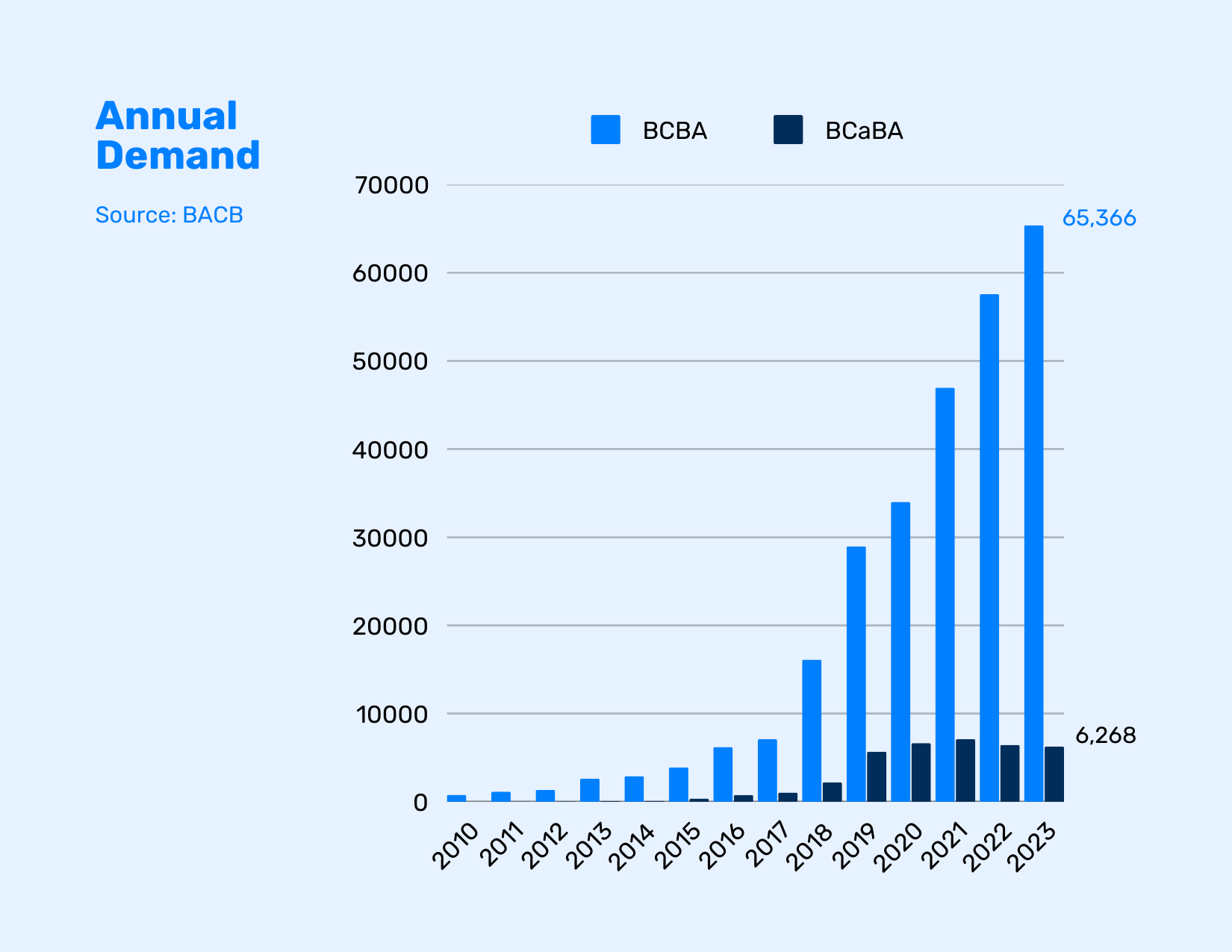If you’re running an ABA practice, you’ve likely felt it firsthand—there just aren’t enough BCBAs, BCaBAs, and RBTs to go around. The ABA staffing shortage is making it harder than ever to hire and retain skilled professionals. Demand for services keeps growing, but the workforce is struggling to keep up. Finding and keeping qualified staff has become a constant challenge, and without the right strategies, the revolving door of turnover can hit an ABA provider hard.
The ABA staffing shortage isn’t just about hiring—it’s about retention, burnout, and the overall sustainability of ABA services. With more clients needing therapy and fewer professionals available, providers must rethink their approach if they want to maintain stability and growth.
ABA Providers Are Hiring—But Where Are the Candidates?
ABA services have never been more in demand. According to the Behavior Analyst Certification Board (BACB), BCBA jobs increased by 14% between 2022 and 2023, continuing a steady rise since 2010.

In 2023 alone, there were 65,300 job postings for BCBAs, nearly matching the total number of certified professionals available.
Yet, despite this growing demand, many ABA providers are struggling to fill positions. The ABA staffing shortage has become a critical issue, affecting the ability of providers to expand services and meet client needs.
One of the primary reasons behind this shortage is the lengthy certification process required to become a BCBA. Unlike many other healthcare professions, ABA professionals must complete extensive coursework, supervised fieldwork, and certification exams before they can practice independently. While demand keeps rising, the number of newly certified professionals entering the field isn’t enough to match it.
Retention is another major challenge that contributes to the ABA staffing shortage. Turnover rates among behavioral health technicians are alarmingly high, with estimates ranging from 45% to 75%, making RBT jobs some of the most in-demand positions in the field.
Many leave due to burnout, low wages, or a lack of career growth opportunities, creating a constant cycle of hiring and training new employees.
A survey from the National Council for Mental Wellbeing found that 93% of behavioral health workers have experienced burnout, with 62% reporting moderate to severe levels.
The emotional toll of the job, combined with heavy caseloads and administrative burdens, is pushing many professionals out of the field. Without intervention, ABA providers will continue to face an uphill battle in recruiting and retaining staff.
How the ABA Staffing Shortage is Impacting Practices
The effects of the ABA staffing shortage are being felt across the industry. Many providers are struggling to keep up with demand, leading to extensive waitlists for new clients. For families seeking early intervention services, these delays can significantly impact developmental outcomes.
The shortage is also placing additional strain on the professionals who remain in the field. BCBAs, BCaBAs, and RBTs are taking on heavier caseloads, increasing their risk of burnout. Overworked staff are more likely to leave, further compounding the problem. High turnover disrupts continuity of care, forcing clients to adjust to new providers and slowing down treatment progress frequently.
In addition to service disruptions, the ABA staffing shortage has significant financial implications. Recruiting, hiring, and training new staff is costly, especially when turnover remains high. Many ABA practices are diverting resources from growth and quality improvement initiatives just to keep their teams adequately staffed.
How ABA Practices Can Adapt and Stay Ahead the ABA Staffing Shortage
1. Rethink Your Recruitment Strategy
Finding new talent in a competitive job market requires a proactive approach. ABA providers can partner with universities and training programs to create a steady pipeline of new professionals. Offering paid internships, mentorship opportunities, and career advancement pathways can help attract emerging talent and reduce turnover. Expanding recruitment efforts beyond traditional job boards—such as networking events, online communities, and professional associations—can also improve the success of recruiting ABA staff.
2. Make Retention a Priority
Keeping skilled professionals in the field is just as important as recruiting new ones. Competitive compensation is essential, but providers should also focus on career development. Creating structured career growth models, such as promoting RBTs to BCaBAs and then to BCBAs, can increase job satisfaction and retention. Some providers, like Hopebridge in Indiana, have introduced alternative leadership tracks for those who do not wish to become BCBAs, allowing them to grow into operational roles. Tuition reimbursement programs can also be an effective hiring and retention tool.
3. Reduce Burnout Before It’s Too Late
Work-life balance is key to preventing burnout. ABA practices should implement manageable caseloads and offer flexible scheduling where possible. Providing mental health resources, peer support programs, and opportunities for professional development can also improve staff well-being. Employees who feel supported are more likely to remain in their roles long-term.
4. Leverage Technology to Lighten the Load
Administrative burdens are a major contributor to burnout in ABA. Using an ABA practice management software can help automate scheduling, billing, and documentation, freeing up time for direct client care. Many providers have also implemented workflow optimization tools to streamline daily operations and reduce inefficiencies.
Designed for ABA Providers
ABA Matrix is an ABA practice management platform that helps you streamline billing, client management, scheduling, data collection, and more so you can focus on quality care.
5. Take Advantage of Workforce Development Programs in Your State
Some states are implementing initiatives to combat the ABA staffing shortage, and providers should take advantage of these resources.
For example, California has expanded workforce development programs, identifying and addressing barriers to entry for behavioral health professionals. Washington has established a behavioral health training facility and scholarship program for students who commit to going into a behavioral health profession. Meanwhile, Tennessee has created residency programs in underserved areas to fill gaps in access. Staying informed about these opportunities can give providers a competitive edge in hiring and retention.
The ABA staffing shortage is one of the biggest challenges facing the field today. Without enough skilled professionals, practices are struggling to keep up with demand, leading to service disruptions, burnout, and high turnover. But ABA providers that focus on improving retention, streamlining operations, and creating a positive workplace culture will be the ones that thrive.
Investing in staff well-being, career development, and technology-driven efficiencies can make a significant difference. Retention strategies that prioritize long-term growth over quick fixes will not only help practices navigate the ABA staffing shortage but also ensure they continue to provide high-quality care for the clients who need it most.
